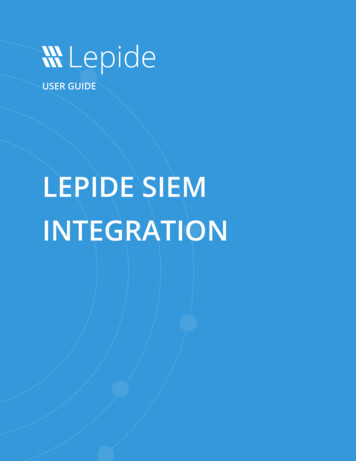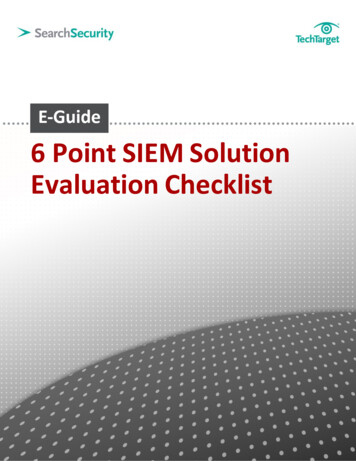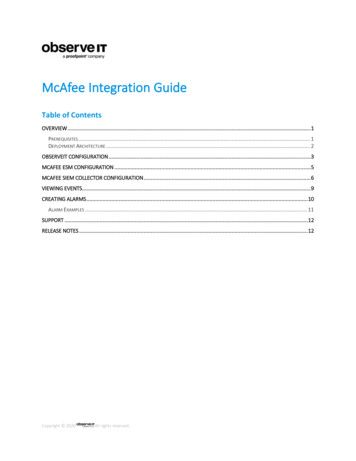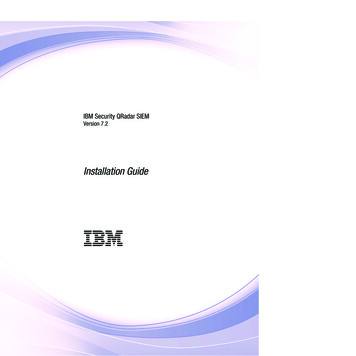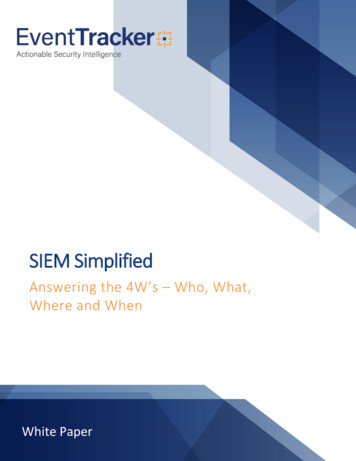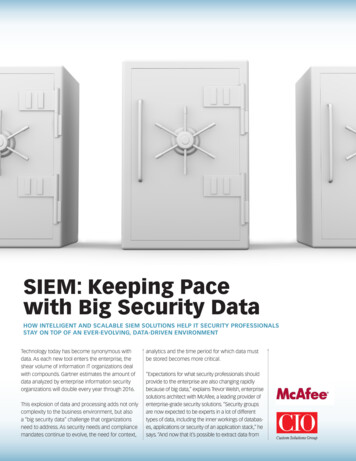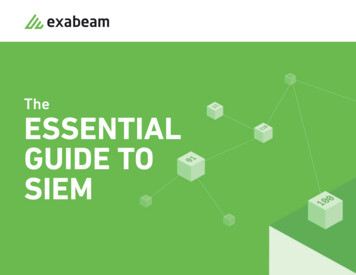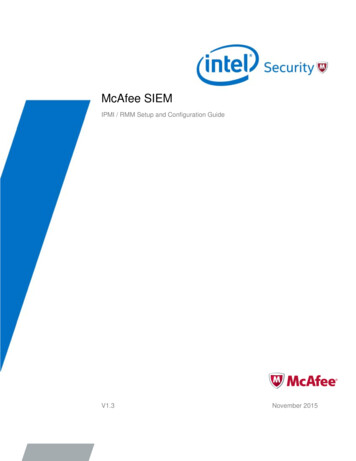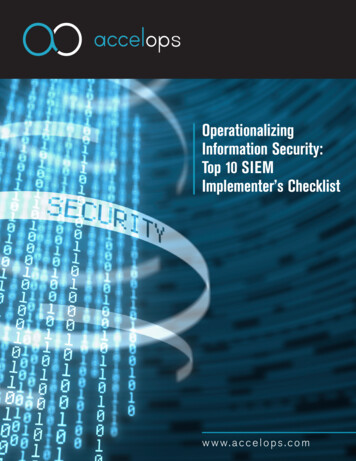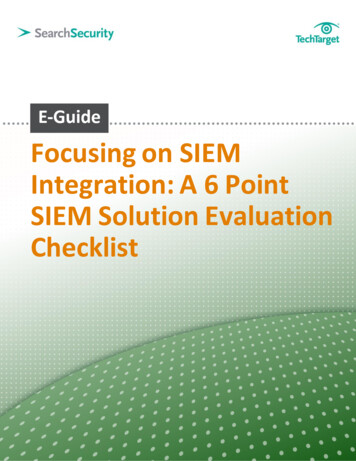
Transcription
Focusing on SIEMIntegration: A 6 PointSIEM Solution EvaluationChecklist
Focusing on SIEM Integration: A 6 PointSIEM Solution Evaluation ChecklistWith the evolution of security information andContents6 Point SIEM SolutionEvaluation ChecklistWhy Focus on SIEMIntegration, CoverageMaximizes AnomalyDetectionevent management (SIEM) tools, it is important to recognizethe benefits of SIEM technology. When implementedproperly, a SIEM system provides a complete picture of thesecurity events that come from a number of activities acrossthe enterprise. This expert E-Guide deep dives into the 6 pointchecklist to follow for an SIEM solution evaluation, and whyyour enterprise should focus on SIEM integration.6 Point SIEM Solution Evaluation ChecklistBy: Satish JaguOver the years, security information and event management (SIEM) toolshave matured to keep pace with the ever growing number of log-generatingdevices, as well as provided value additions to compliance and regulatoryefforts. Considering the cost and wide range of SIEM solutions, we will lookat the things to keep in mind while procuring an SIEM solution.SIEM is the extension to an organization’s log monitoring capability. SIEMsolutions bring in the advantage of automation and intelligence in terms ofanalysis. Correlation is one of the most important functions provided by SIEMsolutions. Earlier, with syslog servers, analysis was performed manually —an impossible task today.From a business perspective, SIEM is usually a compliance and regulatoryrequirement for most certifications. One of the major advantages gleanedfrom implementing an SIEM solution is the perspective it brings to theorganization’s security posture, accessibility and the usable metrics itgenerates. All analysis and dashboards are available on a single console toaid decision making.Given the security edge an SIEM solution it gives an organization, carefulconsideration is due prior to procurement. The following points should bekept in mind while investing in an SIEM solution.Page 2 of 10Sponsored by
Focusing on SIEM Integration: A 6 PointSIEM Solution Evaluation Checklist1.Contents6 Point SIEM SolutionEvaluation ChecklistDevice support:While selecting an SIEM solution, you should pay close attention to thedevices supported by the solution. Ensure that the tool can understandlogs/events generated by devices in use. It should be able to analyze logsfrom devices like firewalls, routers, Unix/Windows servers, antivirus console,IDS/IPS and VPN devices.Why Focus on SIEMIntegration, CoverageMaximizes AnomalyDetectionA customizable option that allows the creation of your own device category isa good feature. The SIEM tool should be able to support logs from unknowndevices like legacy devices and applications, which generate logs in theirown non-standard formats.2.Integration with other applications/tools:Yet another important aspect to consider while shopping for an SIEM solutionis integration with existing applications and tools. A tool that only supportsindependent operation is redundant, and will not give an extended view ofthe organization’s risk posture.Integration with existing tools like vulnerability scanners, the workflow/ticketing system supporting automation, mail/SMS alerting system oreven with the Active Directory (for user management) is a good capability tohave in an SIEM solution. These will extend SIEM functionality and scope.3.Support for groups:Your prospective SIEM solution should be able to support multiple groups,and restrict access on a need-to-know basis for alerts and events.Segregation of groups based on departments and geographic location allowclarity and efficiency while dealing with incidents.For instance, an incident management team in China need not trackincidents in India. If all incidents are fed into the same system, chaos andconfusion will be inevitable. One of the basic information security tenets isaccess on a need-to-know basis.4.Page 3 of 10Reporting:Sponsored by
Focusing on SIEM Integration: A 6 PointSIEM Solution Evaluation ChecklistReporting capabilities of an SIEM solution are the next evaluation criteria.The solution should be able to generate reports/views for various levels ofContents6 Point SIEM SolutionEvaluation ChecklistWhy Focus on SIEMIntegration, CoverageMaximizes AnomalyDetectionpersonnel like technical, mid-level and executive management.From an operational standpoint, different levels need distinct perspectives tomake decisions and perform duties. Management is concerned with businessissues and high-level summaries — they do not need a technical readout.Similarly, security technicians may need to go in-depth, through regularreports that span thousands of lines.5.Regulatory/standards requirements:Check if the SIEM solution supports and understands parameters required tobe monitored as part of regulatory requirements of certifying authorities likePCI DSS and ISO 27001. This also holds true for certifications that yourorganization may be thinking of pursuing, and will help to generate therequired reports in the correct format to be submitted as evidence forcertifications.6.Criticality of devices/servers:Several SIEM solutions provide an option to define criticality of thedevices/servers. This is a good-to-have feature, as it helps rate severity ofalerts based on the device’s criticality. Events can be sorted to achieve themaximum efficiency, and reduce the turn-around times for critical incidents.For instance, a medium severity alert on a high critical server will be ratedhigher, and take precedence over a high severity alert on a less criticalserver. This helps reduce the overall risk to the organization and addressserious issues on a priority basis, efficiently leveraging the available time andresources.Finally, vendor support is critical to be able to make optimal use of your SIEMsolution. This is all the more important when it comes to customization ofSIEM to your organization’s needs.About the author:Page 4 of 10Sponsored by
Focusing on SIEM Integration: A 6 PointSIEM Solution Evaluation ChecklistSatish Jagu is the senior manager for corporate information security atGenpact. With more than 12 years of professional experience in IT, Jagu hasContents6 Point SIEM SolutionEvaluation Checklistexpertise in security, network and system administration on UNIX/Windowsplatforms, security systems and Internetworking devices. He has TCP/IPnetwork experience in design, in addition to implementation of Internet andIntranet services. Jagu has worked on ISO 27001 implementation andcertification projects, as well as SAS 70 and SoX IT controls.Why Focus on SIEMIntegration, CoverageMaximizes AnomalyDetectionWhy Focus on SIEM Integration, Coverage MaximizesAnomaly DetectionBy: Andrew Hutchison, ContributorRecognizing the benefit of SIEM technology, and making the decision toimplement a SIEM system, are important initial steps for an enterprise thattakes security and threat management seriously. SIEM systems can beinvaluable for anomaly detection, but the challenge lies in how best toapproach SIEM, and how to ensure the implementation supports the bestpossible coverage, insight and response.As the security "nerve center" of an organization, a security information andevent management (SIEM) implementation, when done well, gives anenterprise a holistic view of the security events that originate from a wholemultitude of devices, applications and activities across the enterprise. Theadvantage of such a view is that correlation of events can be conducted andpatterns can be identified in ways not possible without such a consolidationof security information.By having a unified view of security-related activity on network devices,firewalls, servers, desktops and even applications such as ant ivirus ortransactional systems, a vigorous SIEM integration effort provides securityoperations teams with a much richer and more accurate knowledge basefrom which to observe, interpret and react to possible threats to theorganization.Page 5 of 10Sponsored by
Focusing on SIEM Integration: A 6 PointSIEM Solution Evaluation ChecklistThe architecture of a SIEM system typically consists of a central processingengine, which is fed by agents or collectors that are distributed throughoutContents6 Point SIEM SolutionEvaluation ChecklistWhy Focus on SIEMIntegration, CoverageMaximizes AnomalyDetectionthe managed environment. A database or storage repository generally holdsevents, and a console for managing and visualizing event activity ispresented. A wide range of SIEM implementations and products is available,but these general characteristics are commonly found in most products.It should be clear that a SIEM's maximum benefit is derived by including ascomprehensive a set of security information feeds as possible. Candidatesfor inclusion should range broadly from infrastructure devices, to applicationsystems, as well as environmental feeds.At an infrastructure level, SIEM agents can be placed on servers ordesktops, firewalls or IDS/IPS devices to propagate security events fromthese sources to the SIEM database and processing engine. In someinstances syslog events are incorporated by the SIEM, and this is one of themost direct and easy ways of integrating system information.At an application level, integration options depend on how accessible andmap-able application originating events are. With many enterpriseapplications, especially those custom built in-house, it can be quite tricky toobtain a feed of security-related events that could be integrated into a SIEMfor monitoring, analysis or response. More customized activity may berequired to include security-related activities from a transactional system orbusiness-specific application than from, for example, antivirus softwaredeployed on a workstation or server. The latter type of software can behelpful in providing an evolving view of how (and where) virus detection isproceeding across an organization. In many instances, antivirus softwaredoes ship with its own console and management system that in and of itselfprovides sufficient reporting, but incorporating antivirus events into the SIEMcan add a valuable dimension to the "view" of organizational security,especially when correlated and analyzed with other types of events.From an environmental perspective, a SIEM can be enriched by having othertypes of information made available to it. In a process-control environment,this could include temperature, pressure or valve status information. In aPage 6 of 10Sponsored by
Focusing on SIEM Integration: A 6 PointSIEM Solution Evaluation Checklistbuilding or facilities management scenario, this could include door accessevents or other traps relating to activities occurring in the environmentContents6 Point SIEM SolutionEvaluation ChecklistWhy Focus on SIEMIntegration, CoverageMaximizes AnomalyDetection(position of elevators, air conditioners or fire systems). One of the big areasof development for SIEM is that of cyber-physical systems, and the type ofenvironmental feeds indicated can bridge the IT infrastructure world of anorganization with its production systems as well.With the integration options indicated, it is important for an enterprise to firstconsider which feeds will be prioritized. Most organizations should considerstarting with the "pillars" of the IT infrastructure, and also the most missioncritical servers and systems. This would include primary servers, keynetworking and communications devices (firewalls, routers and t he like), keysecurity defenses (intrusion prevention systems) and then looking further todesktops and their applications. Prioritization should be, in a sense, threatdriven: the areas where an attack could cause greatest damage should beidentified first.An effective approach can be to identify phases whereby an initial round ofintegration is implemented (especially where off-the-shelf connectors can beused, as opposed to custom-built connectivity for in-house applications, forexample). If there are already connecter elements in the SIEM software (as amechanism to import events from a particular system), then those feedswould also be easier than complex event formats that may requirecustomization of the connecters. This is followed by another phas e ofintegration where connectivity and event-format mapping may require morecustomization and time.Once the feeds are incorporated and the best possible coverage has beenachieved, security operations teams must spend time understanding theevent patterns and getting a "feel" for normal activity vs. unusual activity. Thebeauty of using a SIEM system is that different views and visualizations aregenerally provided, and combinations of event streams can be overlaid tooffer further insight into activity patterns that may seem suspicious. In thisway SIEM operators can "zoom in" and get detailed insight into the managedenvironment.Page 7 of 10Sponsored by
Focusing on SIEM Integration: A 6 PointSIEM Solution Evaluation ChecklistNaturally, initial analysis will quickly dictate the need for tuning, which oftenincludes the narrowing or broadening of focus. Voluminous event feeds suchContents6 Point SIEM SolutionEvaluation Checklistas antivirus may actually be to filtered out if they are not providing usefulinformation. Pre-processing at nodes and/or servers is done in SIEMs soonly some or certain most relevant event types are propagated. A relatedapproach some may consider is integrating the antivirus managementsystem as a consolidated feed into the SIEM. For example, using SNMPWhy Focus on SIEMIntegration, CoverageMaximizes AnomalyDetectionmessages from the antivirus management system itself, incorporatingaggregated and/or interpreted information, may be easier than drawing inraw antivirus system data. This sort of tactic can help to reduce some of thevolume that can overwhelm a SIEM (and make it difficult to "find" the relevantactivity that is crucial in any anomaly detection effort). The danger of filteringout too much too soon is that it can dilute the insight and effectiveness thatcan be achieved.The final question relating to using SIEM for anomaly detection is how toensure appropriate and necessary response. The intent of the SIEM is thatsecurity operations teams can become more proactive and equipped todetect and respond to security threats. Once the SIEM has beenimplemented and "tuned" to the environment, response and interventionplans should be tested and assessed so that, if necessary, t echnical orpersonnel originating actions can be performed quickly and exactly tomitigate a perceived threat. In the best case, early warning and detection ofattacks should be possible, but after-the-fact review and analysis can also behighly valuable to understand what may have happened and to implementrules or pattern profiles to ensure such activities (or combinations thereof) donot become a threat to an organization again.More powerful techniques of anomaly detection and big data-type processinghold the promise of ever more effective SIEM deployments in the future. Butby following the SIEM coverage, integration and response recommendationsoutlined here, organizations become poised to benefit from these new andhelpful analysis techniques as they are embraced by SIEM software andservice providers.Page 8 of 10Sponsored by
Focusing on SIEM Integration: A 6 PointSIEM Solution Evaluation ChecklistAbout the author:Andrew Hutchison is an information security specialist with T-SystemsContents6 Point SIEM SolutionEvaluation ChecklistInternational in South Africa. An information security practitioner with 20years of technical and business experience, his technical security work hasincluded secure system development, security protocol design and analysis,and intrusion detection and network security solutions. He has held executiveresponsibility for information security in a large enterprise, establishing itsWhy Focus on SIEMIntegration, CoverageMaximizes AnomalyDetectionchief security officer role and initiating an ISO27001 security certificationprogram. As business sponsor for large SIEM rollouts, he has experience indeploying and operating SIEM systems in a managed service providerenvironment. He is an adjunct professor of computer science at theUniversity of Cape Town in South Africa.Page 9 of 10Sponsored by
Focusing on SIEM Integration: A 6 PointSIEM Solution Evaluation ChecklistContentsFree resources for technology professionalsTechTarget publishes targeted technology media that address your need for6 Point SIEM SolutionEvaluation Checklistinformation and resources for researching products, developing strategy andWhy Focus on SIEMIntegration, CoverageMaximizes AnomalyDetectionWeb sites gives you access to industry experts, independent content andmaking cost-effective purchase decisions. Our network of technology -specificanalysis and the Web’s largest library of vendor-provided white papers,webcasts, podcasts, videos, virtual trade shows, research reports and more—drawing on the rich R&D resources of technology providers to addressmarket trends, challenges and solutions. Our live events and virtual seminarsgive you access to vendor neutral, expert commentary and advice on theissues and challenges you face daily. Our social community IT KnowledgeExchange allows you to share real world information in real time with peersand experts.What makes TechTarget unique?TechTarget is squarely focused on the enterprise IT space. Our team ofeditors and network of industry experts provide the richest, most relevantcontent to IT professionals and management. We leverage the immediacy ofthe Web, the networking and face-to-face opportunities of events and virtualevents, and the ability to interact with peers—all to create compelling andactionable information for enterprise IT professionals across all industriesand markets.Related TechTarget WebsitesPage 10 of 10Sponsored by
SIEM Solution Evaluation Checklist Page 3 of 10 Sponsored by Focusing on SIEM Integration: A 6 Point Contents 6 Point SIEM Solution Evaluation Checklist Why Focus on SIEM Integration, Coverage Maximizes Anomaly Detection 1. Device support: While selecting an SIEM solution, you should pay close attention to the devices supported by the solution.
